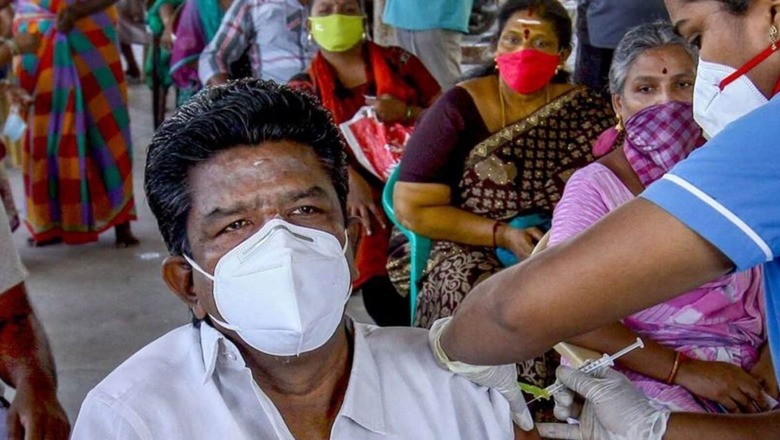
views
In his recent address to the nation, Prime Minister Narendra Modi hailed India’s vaccination drive on the occasion of the country crossing the landmark 100-crore shots. The successful drive, he said, has played a vital role in economic recovery and growth.
The vaccination drive has been the booster shot for India’s economy, driving optimism, higher investments, more jobs and, overall, a much brighter future. And, Prime Minister Modi has led this effort all the way despite unfounded and biased criticism and pessimistic projections by many naysayers.
The Indian economy is now truly bouncing back from the lows of the last year, which were a result of the COVID-induced lockdown. The first quarter of FY 2021-22 saw a GVA (gross value added) expansion of 18.8 per cent (at constant prices) as against a decline in the first quarter of last year. We must remember the bounce back in the first quarter of this year too was affected by the second wave of COVID-19 and the partial lockdowns across the country.
When one looks at the data for the first quarter of this financial year, the area of concern continues to be services, especially trade and retail, which were badly affected due to lockdown. Other areas of the economy are doing well.
ALSO READ | Narendra Modi’s Gettysburg Moment—A Billion Doses
The banking sector has come out of the NPA crisis. Gross NPAs have reduced from 15 per cent of the total lending in 2018 to around 7 per cent today, and the recent record profits by the private banks show the banking sector has fully healed. We have also seen many public sector banks come out of the PCA (prompt corrective action) framework. Interest rates have now come down by around 2 percentage points from 8.5 per cent—and the industry is enjoying its benefits.
A large section of the industry has paid back a huge chunk of its borrowings to the banking sector. Deposits have grown at about 9.5 per cent in the last 12 months and lending has grown around 6.5 per cent. Overall, the banking sector is now infused with sufficient capital and liquidity and has the challenge of higher lending. This reflects in the stock prices of banking firms and this is a good sign.
The housing loan sector has seen a huge uptick with sizeable registrations in major markets like Mumbai and other cities, driven by lower inflation and low interest rate of 6.5 per cent. The middle class and the lower middle class seem to buying houses, especially after they have realised during COVID that they need bigger houses.
The real estate sector, a major driver of the Indian economy, has bounced back too. Because of the housing sales, debts are being repaid and balance sheets of companies in this sector are looking fairly healthy. New projects have also been kicked off, which is a healthy sign.
The capex (capital expenditure) cycle of the private sector has been a weak point for the last five years, but we are now witnessing many announcements on capacity expansion—and this augurs well.
The infrastructure sector continues to do well with the government spending at an all-time high; the government has substantially stepped up its allocation for capex to Rs 5.9 lakh crore, which is encouraging. Many other pending infrastructure projects are getting completed and people are beginning to enjoy their benefits.
Tax collection is at an all-time high, with indirect and direct taxes for the five-month period up to August showing a growth of 75-80 per cent. The fiscal deficit for the five-month period has come down substantially. There is hope that the total tax collection for this year may see an increase of Rs 2-3 lakh crore over last year. The Finance Ministry has recently said it will not borrow beyond the Rs 12.5 lakh crore borrowing it budgeted for this year despite having to give out around Rs 1.5 lakh crore as GST compensation and higher expenditure.
The bright spot, of course, has been the IT sector—most of the top listed companies have seen double-digit growth in the second quarter and expect double-digit growth for the next two years, at least. The top five companies have hired nearly 100,000 people in the first six months of the year. Analysts say more than 600,000 jobs will be created in the IT and startup sector.
This year so far, we have seen 34 unicorns emerge across sectors—around USD 22 billion have flown into venture and startup sector. India, today, has 74 unicorns and we will possibly end the year with USD 25-30 billion capital and around 80 unicorns. By December 2025, India will hopefully have 200 unicorns with a total market value of USD 1 trillion as against USD 400 billion now. In this quarter, we hope to see many more startups taking the IPO route.
ALSO READ | Road to a Billion Shots: How India’s Covid Vaccination Drive Picked Up Pace Despite Speed Bumps
Jobs are being created at an encouraging pace if one looks at the Employees Provident Fund Organisation (EPFO) data for formal sector jobs. The EPFO/ESIC (Employees State Insurance Corporation) data is most authentic because only when a job is created and social security benefits provided, the number gets registered.
If one looks at the corporate sector profits, they have improved since the September quarter of last year on the back of higher growth and recovery and reduced corporate tax rate of 25 per cent. The reduced corporate tax rate has made sure that corporates pay back their debts, improve their balance sheet, with a debt equity of top 600 non-financial companies coming down to 0.7 from 1.0, two-three years ago.
Overall, if one looks at the economy, there is hope. India’s GDP in this quarter will come back to the pre-COVID times. All global firms and analysts like the World Bank, IMF and others expect India’s real growth to be around 8.5-10 per cent, which I believe will be exceeded.
Along with inflation of around 5 per cent this year, we could see a nominal growth of 13.5-15 per cent, and this growth is expected to improve in the years to come. What has happened in India over the last 3-4 years, despite COVID, is that there has been an improvement in efficiency; supply-chain cost that stood at nearly 14 per cent of GDP five years ago is hopefully down to 10-11 per cent because of GST and massive improvement in road and rail transport.
Industry has cut costs and become more efficient due to COVID. Debts have been paid back by many corporations in many basic industries. The IBC resolution and all other painful reforms have been put through and it augurs well for the Indian economy. India is hopefully set to grow to a 5-trillion USD economy by 2026, with creation of jobs in the future. We are all optimistic about India’s growth.
The author is Chairman, Aarin Capital Partners. The views expressed in this article are those of the author and do not represent the stand of this publication.
Read all the Latest News , Breaking News and IPL 2022 Live Updates here.














Comments
0 comment